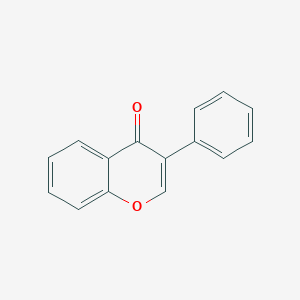Details of the Drug
General Information of Drug (ID: DM7U58J)
| Drug Name |
Isoflavone
|
|||||
|---|---|---|---|---|---|---|
| Synonyms |
Isoflavone; Isoflavone (8CI); Isoflavone skeleton; LS-191186; MCULE-2586547916; OVO2KUW8H8; SBB068618; SCHEMBL8028; ST098957; VN10014; ZINC895390; isoflavon; 3-Phenylchromone; 3-phenyl-4H-1-benzopyran-4-one; 3-phenyl-4H-chromen-4-one; 3-phenylchromen-4-one; 4H-1-Benzopyran-4-one, 3-phenyl-; 574-12-9; AC-12802; AK114020; AKOS015918505; AX8135136; BCP22856; BCP9000133; CCG-214095; CHEBI:18220; CHEMBL366460; CS-W006405; DB12007; DS-6374; DTXSID90205986; KS-00000GFW; NSC 135405; NSC-135405; NSC135405; GOMNOOKGLZYEJT-UHFFFAOYSA-N; UNII-OVO2KUW8H8
|
|||||
| Structure |
 |
|||||
| 3D MOL | 2D MOL | |||||
| #Ro5 Violations (Lipinski): 0 | Molecular Weight (mw) | 222.24 | ||||
| Logarithm of the Partition Coefficient (xlogp) | 3.2 | |||||
| Rotatable Bond Count (rotbonds) | 1 | |||||
| Hydrogen Bond Donor Count (hbonddonor) | 0 | |||||
| Hydrogen Bond Acceptor Count (hbondacc) | 2 | |||||
| ADMET Property |
|
|||||
| Chemical Identifiers |
|
|||||
| Cross-matching ID | ||||||
Molecular Interaction Atlas of This Drug
 Drug-Metabolizing Enzyme (DME) |
|
|||||||||||||||||||||||||||||||||||||||||||||||||||||||||||||||||||||||
|---|---|---|---|---|---|---|---|---|---|---|---|---|---|---|---|---|---|---|---|---|---|---|---|---|---|---|---|---|---|---|---|---|---|---|---|---|---|---|---|---|---|---|---|---|---|---|---|---|---|---|---|---|---|---|---|---|---|---|---|---|---|---|---|---|---|---|---|---|---|---|---|---|
 Drug Off-Target (DOT) |
|
|||||||||||||||||||||||||||||||||||||||||||||||||||||||||||||||||||||||
| Molecular Interaction Atlas (MIA) | ||||||||||||||||||||||||||||||||||||||||||||||||||||||||||||||||||||||||
References
